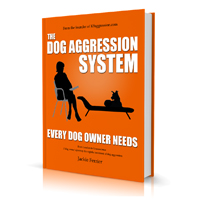Your cart is currently empty!
Control Barking

Dogs bark for a variety of reasons, from boredom, and frustration to anxiety to just straight up communication, and some breeds bark more than others.
But there comes a point where excessive barking can not only be very annoying but can cause problems with your neighbours. Understanding why your dog is barking is the first step toward controlling it.
Certainly many dogs bark when someone is at the door. This is the equivalent of a dog warning its pack that there are approaching strangers or possible intruders. This is not necessarily something we want to prevent, but over time an anxious dog can grow to be more anxious and the barking becomes excessive.
Here are some of the potential reasons dogs bark:
- Welfare Issues, anxiety or distress
- Separation Anxiety
- Social or territorial or Alarm Barking
- Attention Seeking
- Barking from confusion or frustration
- Play
- Barking due to Fear or Aggression
- Barking related to a disorder or dysfunction
- Predatory barking
Dr Sophie Yin conducted a survey of people who owned dogs that barked. (996 survey responses). Approximately 88% of these barked when they were stimulated by squirrels, sounds, people walking by and other dogs.
More than half barked when they played. Almost half barked to seek attention, and approximately 10% barked for unknown reasons including boredom.
But there are other concerns with barking. For example, barking can considered to be a sign as an indication of poor welfare. (1) So barking might be an important signal you should investigate. Is your dog getting all their needs met? Is your dog battling with a hidden illness?
A large percentage of dogs barked both when their owners were home and when they were not, indicating that training when the owners were home could potentially have some effect when they owners were not.
Attention Seeking

If you think your dog is barking for attention, you will need to determine whether it is a learned habit, or a symptom of a greater problem. If it is a learned habit we have good and bad news for you. First the good news:
Learned behavior can be be replaced with other learned behaviour.
And now the bad news:
- The longer your dog has practiced the habit of barking for attention the harder it will be to change it.
- Inconsistently responding to your dog barking for attention makes it even more difficult to change it, than it would be if you always responded to it.
- If you are consistent in ignoring him or her, it will get worse before it gets better. This is known as an extinction burst. Essentially it means the dog will try even harder to make the barking work for them until they finally give up.
- Giving in once may re-establish the annoying habit.
- It’s hard to make other people follow the rules (if this is the case for members of your family, you might be interested in this article: Secrets to getting your significant others on board with your dog training.
- Sometimes it just feels good for your dog to bark – that means they are barking for their own reasons and rewarded by it.
First make sure your dog’s needs are met. Feeding and walking your dog at the same time of day will help your dog know when to expect things.
Environment enrichment, training, play and exercise may help change this habit as well. Teaching your dog not to bark may be effective as well. For a helpful video on how to do this, see the video farther down the page below under Treatment > Positive Reinforcement.
Treatment for Excessive Barking
The goal here is to reduce barking. You might use one or a combination of the following techniques and tools to help you.
Note that it is unrealistic to attempt to eliminate it altogether. If you have issues with neighbours, you may have to consider moving if they are unable to tolerate any of it.
Medications for Anxious Dogs
For those dogs who are barking due to anxiety, whether separation or otherwise,may benefit from a medication that can help treat the anxiety such as fluoxetine (Reconcile™). Clomipramine is another medication that is used to treat separation anxiety. Unfortunately, Clomipramine is considered to have reduced effect in excessive barking (5). There are always potential side effects of medication, and medication without a behavioral therapy usually is not as nearly effective.
DAP (Dog Appeasing Pheromone)
Pheromones are chemical substances that are released by an animal that affects the behavior of others in the same species.
DAP is a synthetic analogue of the group of pheromones that are secreted by mother dogs after giving birth. These seem to have an appeasing affect both on young and adult animals. It has been considered to be at least as effective as Clomipramine when both are used with a behavioural plan (3) An electric diffuser can deliver DAP can be used which makes it easy.
DAP, in combination with a behavioural plan, can often quickly reduce the undesirable behaviours exhibited by dogs suffering from separation-related problems and overattachment to their owners.
Check out the dog appeasing pheromone diffusers (#ad) on Amazon.
Interomones
Interomones are pheromones in one species that can effects other species.
Research is early at the time of this writing, but there are indications that interomones may help control barking in clinically anxious dogs demonstrating excessive barking and jumping up. (6)
For barking due to fear or aggression
Read on, but also check out the treatment methods for dealing with aggression.
Behavior Modification
Behavior modification includes techniques like Classical Conditioning, desensitization and counter conditioning. These techniques work at dealing with the underlying causes of barking, by either:
- Desensitizing them to whatever is setting the barking off
- Developing new positive associations with whatever is setting the barking off so they are less likely to bark
- Training them to do something that is incompatible with barking such as sitting, looking at you and remaining calm.
- Another alternative can be to give them a job to do.
Classical Conditioning
Classical conditioning does not involve teaching the dog to do anything. It merely takes advantage of the dog’s own inherent – and involuntary – learning. In the case of aggression, we are looking to to evoke an involuntary response (such as salivating) physiological response.
Classical conditioning for an anxious dog at the door
Case study: Dog was anxiously barking in a new apartment building There was a case of a woman in an apartment dwelling that used a remote treat delivery system to encourage people outside in the hall to remotely deliver a treat to the dog inside whenever they went by.
In time, strange sounds in the hall stopped being so alarming. Soon they became predictors of treats. In this way, sounds stopped being “strange” and started to became known. In addition rather than the sounds predicting the onset of anxiety, it predicted something to look forward to.
Read about it here: Moving with Minnie. It’s a good read!
Remote Treat Dispensers
These tools are for the above situations. These are affiliate links to Amazon which means we get a small commission if you buy at no cost to you, but we only encourage you to buy what you think will helpful! These are not the cheapest tools to use but we know people who have used them when nothing else would do.
Premier Treat & Train Remote Reward Dog Trainer (#commissionearned) is the defacto remote control treat dispenser invented by the late Dr. Sophie Yin.
These can be used for a variety of different training scenarios. For example, if you dog barks at the door, you can use these beside your dog’s bed while you answer the door.
There is a new remote treat dispenser on the market that uses wifi and video to allow you to treat from anywhere. This would allow you to operate it while you were out of the home.
Petzi Treat Cam: Wi-Fi Pet Camera & Treat Dispenser (#ad)
There are a variety of pet cameras on the market as well. Some allow you to speak to your dog which provides them with a little interaction while allowing you to see what your dog is up to. If your dog is bored and lonely this may help, as hiring a dog walker might as well.
Classic conditioning for dogs reacting aggressively at the door
Classical conditioning has been used for aggressive dog at the door. This involves hundreds and hundreds of repetitions over a period of several weeks of ringing the doorbell.

The idea is that the dog eventually starts to develop the association of the bell or knock with the coming of food. The anticipation of this food will start the dog to salivate(and now you understand why so many darned repetitions are needed to compete with previous associations).
The point? The desire – the salivating – is part of the parasympathetic nervous system. This is parasympathetic nervous system is thought to be largely incompatible with the sympathetic nervous system which is part of our stress response.
At this point, the dog is still aggressive. However the edge has been taken off the dog do that operant conditioning can be effective (see more below).
Care must be taken not let someone in the house while the dog in there until the intensity of the dog’s response has been reduced substantially. Once this occurs, you can start to desensitize the dog to going to the door, reaching for the knob, opening the door, etc. The goal here is to break down all of the activities and situations that the dog has come to use to predict someone is coming in.
Desensitization
Many confuse desensitization with counter conditioning because desensitization often occurs while counter conditioning. But it’s important to understand they are different things. Desensitization occurs when a dog becomes less sensitive to something.
However people sometimes think they are desensitizing, when it fact they are using flooding which can often have a very negative effect. The main difference between the two is that in the case of flooding, the dog is exposed to he thing he or she is anxious or afraid of until he is no longer afraid. Clearly this can backfire and result in a traumatized dog that is even more reactive.
Desensitization depends on the dog being able to be calm. This means you need to find a distance (or duration) where the dog is only on the edge of an emotional response. If the dog cannot calm down it must be moved away from the trigger of the response immediately.
The focus on desensitization is achieving a calm relaxed state within the presence of his or her trigger.
Using a less stimulating approximation of your dog’s trigger to desensitize
Creating low-stimulating “approximations” (similar sounds like another kind of bell or knocking or a recording) of the sound may help your dog desensitize to the sound. For example for a dog that reacts to knocking, lightly knocking on a table. Use a recording of your doorbell and play it quietly, and slowly increase the sound as your dog manages to remain calm.
You will need to be creative. If your dog reacts and cannot be calm, you need to go back to or find a less stimulating example.
Counter conditioning on the other hand is specifically focused on teaching the dog to do an incompatible behavior to the one you are trying to change. So while it’s possible for the dog to be taught to do something incompatible, the dog still might be anxious. While still anxious they still have a strong likelihood of reacting if motivated enough.
Positive reinforcement, operant conditioning, counter conditioning
Positive reinforcement, in other words, rewarding the dog for being quiet is believed to be more effective to control barking than anti-barking devices (2). Using positive reinforcement for rewarding a desirable behavior incompatible with the problem can be called operant conditioning go or counter conditioning. Operant conditioning in this case above would have the dog do something incompatible with barking such as sit calmly and quietly. Once they are calm and quiet they are rewarded for doing so.
Check out this video below on how to teach the dog to bark and be quiet. You should have a basic understanding of clicker training to understand how the trainer is using the clicker to get what he wants from the dog.
Prevention of barking triggers
Since so many dogs response when stimulated, it may be possible to at least cut down on the stimulation in some cases.

For example, in the case of a hyper vigilant dog who is always looking through windows outside, it may be possible to use something such as a window cling like this Non-Adhesive Frosted Window Film, to let in light, but mask outside activities.
Sound may help to muffle the trigger sounds, but is not consistently effective because dogs have very good hearing.
Prevention of barking triggers
Since so many dogs response when stimulated, it may be possible to at least cut down on the stimulation in some cases.
Use something to reduce stimulation
For example, in the case of a hyper vigilant dog who is always looking through windows outside, it may be possible to use something such as a window cling like this Non-Adhesive Frosted Window Film (#commissionearned), to let in light, but mask outside activities (by the way, this is an affiliate link!)
Adding sound may help to muffle stimulating sounds, but is not consistently effective because dogs have very good hearing. You are better off looking to see if there is some way to pair these sounds with a treat. See Improve barking creatively.
Head halters
You may be interested in this article on managing dog aggression by using a head halter. Check this video out by veterinary behaviorist Dr. karen Overall for a demonstration on how to use one for barking at the door.
Environmental enrichment
Environmental Enrichment as mentioned above is a relatively passive way to improve behavior problems and stress in many animals. It is a key factor in reducing distress in shelter animals. It may or may not help depending on the causes for your dog’s barking. Check out our information on environment enrichment for dogs. The article is directed towards aggression in dogs, but it can have behavioral benefits on all dogs.
Problems with anti-bark collars
Anti-bark collars showed some short term effectiveness (54 and 66% for citronella and ecollar respectively), but neither was effective long term.
Close to 40% of dogs controlled with e-collars showed adverse effects most commonly fear of the collar itself or fear of the area were they had experienced the shock.
While intermittent use may be the most effective, findings indicate that dogs generally get used to the citronella spray collar regardless of how the animal is exposed to the device.(4)
Problems with using muzzles to stop barking
Muzzles can be an excellent tool when preventing a dog from biting or controlling aggression, but they are problematic because the dog is unable to pant. This can be dangerous in summer. In addition it makes it difficult to eat or drink which means rewarding the dog with a treat for being quiet is difficult.
Finally for these various reasons, a muzzle which prevents the mouth can increase the risk of frustration, and in turn increase the risk of aggression. You are better off trying to treat the cause, than using a muzzle.
You might also be interested in this post on improving barking in time for halloween or this creative way to deal with barking which link to the case study above in more detail.
References
[1] Stephen JM1, Ledger RA. An audit of behavioral indicators of poor welfare in kenneled dogs in the United Kingdom., J Appl Anim Welf Sci. 2005;8(2):79 96. http://www.tandfonline.com/doi/abs/10.1207/s15327604jaws0802_1#.VtX_I2SrRhE
(2) Yin S., Richardson S., Excessive barking: When and Why it Occurs, https://drsophiayin.com/app/uploads/2015/04/SYinBarkingPoster.pdf
(3) E. Gaultier, L. Bonnafous, L. Bougrat, C. Lafont, P. Pagea, Comparison of the efficacy of a synthetic dog-appeasing pheromone with clomipramine for the treatment of separation-related disorders in dogs, The Veterinary Record, April 23, 2005, https://www.researchgate.net/profile/Patrick_Pageat/publication/7888981_Comparison_of_the_efficacy_of_a_synthetic_dog-appeasing_pheromone_with_clomipramine_for_the_treatment_of_separation-related_disorders_in_dogs/links/0a85e534e265e66285000000.pdf
(4) Wells D., The effectiveness of a citronella spray collar in reducing certain forms of barking in dogs, Applied Animal Behavior Science, August 27, 2001Volume 73, Issue 4, Pages 299–309, http://www.appliedanimalbehaviour.com/article/S0168-1591(01)00146-0/fulltext?mobileUi=0
(5)Michio Takahashi, Makoto Bannai, Shinobu Seki, Methods for reducing excessive barking of a dog , Patent, Grant application https://www.google.com/patents/US6939894
(6)McGlone JJ, PAS, Thompson WG , Guay KA,1 PAS, CASE STUDY: The pig pheromone androstenone, acting as an interomone, stops dogs from barking, The Professional Animal Scientist 30 ( 2014 ):105–108, http://www.professionalanimalscientist.org/article/S1080-7446(15)30091-7/pdf
ADVERTISEMENT
The Dog Aggression System Every Dog Owner Needs E-book

Anxious Dog Shirts only available in our shop

Keep people away with our Stand back shirts

